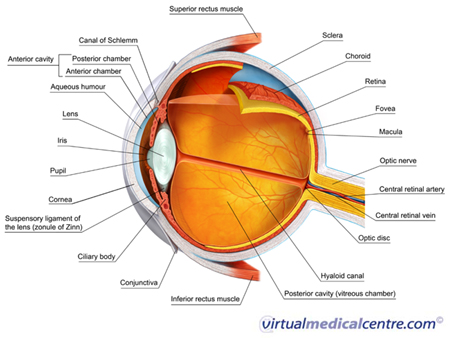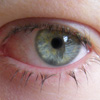- What is Vernal Keratoconjunctivitis (VKC)?
- Statistics
- Risk Factors
- Progression
- Symptoms
- Clinical Examination
- Prognosis
- Treatment
- Vernal Keratoconjunctivitis (VKC) Prevention
- References
What is Vernal Keratoconjunctivitis (VKC)?
Conjunctivitis is a very common reason for experiencing an uncomfortable, red eye. There are a number of causes for conjunctivitis, including bacteria, viruses and, importantly, allergies. Allergic conjunctivitis affects the conjunctiva of the eye. The conjunctiva refers to the thin, translucent lining of the eyeball and the undersurface of the eyelids.

Vernal keratoconjunctivitis (VKC) is a particular type of allergic conjunctivitis. VKC usually affects both eyes, follows a more long-term course, and is strongly linked to a personal or family history of other allergic diseases.
Statistics
Most people affected by allergic conjunctivitis experience simple allergic conjunctivitis. Other forms of conjunctivitis make up a small proportion of cases, with about 2% of all allergic conjunctivitis cases due to VKC and atopic keratoconjunctivitis together. In one large study, about 3 out of every 10,000 people surveyed were found to have VKC.
The number of people affected by VKC varies with the season and the country where an individual lives. For example, the rate of VKC is higher in Italy, Japan and other warmer climates. VKC is more commonly experienced by males.
Risk Factors

Family and personal history
Your family and personal history are important to consider. Up to 75% of people VKC have experienced allergic diseases previously, such as asthma, eczema or hayfever (allergic rhinitis). In addition, about 40–60% of people with VKC have one or more family members affected by these allergic conditions.
Environment and season
The environment, including geographical location and season is also important. For example, people living in warmer tropical and temperate areas, such as in Mediterranean areas, the Middle East and Africa, are more likely to experience VKC than those in cooler zones. VKC is also more common in the summer.
Age
VKC is more often experienced in childhood and adolescence and it is most common between 4 and 20 years of age. It is estimated that about 80% of people affected by VKC experience symptoms before the age of 10 years.
Gender
VKC is more common in boys and young adult men. The risk of VKC in boys compared to girls is 2–4 times higher. However, in older persons, the male to female ratio is approximately equal.
Progression
The progression and course of VKC is variable. Some people experiencing VKC may find that the condition spontaneously resolves, while others may find it gradually settles as they grow older, often resolving by puberty.
Symptoms
It is important that anyone with eye symptoms visits their doctor and provides a detailed clinical history. The doctor will rule out other types of conjunctivitis and more serious conditions that may cause uncomfortable red eyes.
The doctor will pay close attention to several aspects of your clinical history. In particular, they may ask:
- Have you had recent exposure to other people with conjunctivitis or an upper respiratory tract infection? This may suggest a viral cause of conjunctivitis.
- What are the details of your sexual history? In particular, have you had Chlamydia or Gonorrhoea? These can both cause conjunctivitis.
- Are you using any prescription or over-the-counter medications? Some medications can cause inflammation.
- Have you had any eye diseases before, used contact lenses, or had any other conditions that can be associated with eye conditions (e.g. rheumatoid arthritis)?
- Has anyone in your family had allergic conditions (e.g. hayfever, asthma or eczema)?
People with VKC most often experience itching and photophobia (sensitivity to light).Unlike the mild itching that most often occurs in other forms of allergic conjunctivitis, the itching that accompanies VKC may be more severe. There may also be the uncomfortable sensation that there is something in your eye, a mucous discharge and eyelid twitches (blepharospasm). People may experience ptosis (drooping of your eyelid) due to small swellings on the underside of the eyelid. Individuals may also find that their symptoms are worse with warmer weather and that nasal symptoms, such as a runny nose, accompany their eye symptoms. In severe cases of VKC, ulcers may form on the cornea, called shield-ulcers; if these form scars, they may affect your vision. However, these complications can be avoided if you see your doctor as soon as you notice eye discomfort.
If you have a red eye without itchiness, you may have a different eye condition. In this case, it is extremely important to seek medical advice from a doctor as soon as possible.
If you experience severe, continuous eye pain and reduced vision, promptly seek the advice of a doctor and you may need urgent referral to an ophthalmologist. These features are not typically present in allergic conjunctivitis and may point to a more serious eye condition.
Clinical Examination

The doctor may also use an ophthalmoscope to view the back of your eye, or a slit-lamp microscope to see the front structures of your eye. Both of these are painless, routine examinations.
Prognosis
Initially VKC demonstrates seasonal variation, with the symptoms and signs more pronounced during the warmer months of spring and summer. Often when the condition is present for three or more years, individuals may find that the seasonal variation in their symptoms lessens.
The eventual outcome of VKC may be indicated by several factors, such as how long the person has had the condition and how severe their symptoms have been. For example, about 16% of people who have had the condition for three years will develop a more long-term, year-round form of VKC.
In VKC that develops papillae, larger swellings are associated with a worsening, or persistence of the condition over time. Other features such as eyelid and eyelash involvement (development of long thick eyelashes) suggest a more severe disease. If ulcers form on the cornea, vision may be reduced.
Treatment

Non-pharmacological therapy
Two useful strategies for dealing with VKC include using a cool compress over the eyes and air-conditioning to cool the environment to an appropriate temperature. This may be helpful in VKC cases that are made worse by warmer environments.
Try to avoid rubbing or touching your eyes, as eye-rubbing may result in more inflammation.
Some people find eye lubricants and refrigerating eye drops to be effective at soothing the eyes. Eye drops and lubricants dilute the factors that trigger allergic symptoms.
Pharmacological treatment
There are a number of different medications that can be used to treat VKC. The exact treatment plan will depend on how severe your symptoms are and what you may already have tried to treat your symptoms. In many cases, your immediate symptoms will be controlled with a short-term treatment program, followed by a longer-term maintenance plan. If you find your symptoms are not improving or are getting worse despite treatment, return to your doctor as soon as possible for a review.
Decongestants
The symptoms of allergic conjunctivitis arise because the chemicals released in response to the allergic trigger prompt a number of changes and inflammation. The small blood vessels in the eye enlarge, contributing to the redness, itchiness and discomfort experienced.
Decongestants are effective for several types of allergic conjunctivitis, including VKC, and are available in eye drop form. They keep the small blood vessels constricted, and in doing so, may provide some relief from allergic conjunctivitis. Side effects can occur if they are over-used or used for a long time, so they must be used following your doctor’s instructions.
Antihistamines
Many of the symptoms in allergic conjunctivitis are due to histamine. Histamine is released by cells in response to an allergic trigger, and causes itching, enlargement of the blood vessels and a number of other inflammatory changes.
Short-term relief of the itching and redness can be provided by topical antihistamines and vasoconstricting eye drops.
Antihistamine agents attach to the same cells in your body as histamine, and in doing so prevent histamine from attaching to these cells. When there is a greater quantity of antihistamine, histamine is unable to bind to cells in the eye. As itching is only triggered when histamine binds to cells, antihistamines prevent or minimise the itchiness, redness and discomfort caused by histamine.
Mast cell stabilisers

People with VKC who experience less prominent symptoms in autumn and winter may be able to discontinue their mast-cell stabilser medications for a period during these seasons. Mast cell stabilisers are effective in most people and are generally safe, but like all medications should only be used according to your doctor’s advice.
NSAIDS
Topical NSAIDs may be considered in some cases of VKC, as they reduce itchiness and redness. NSAIDs do this by blocking enzymes involved in producing the chemicals that contribute to allergy and inflammation. Significant side effects can occur with NSAID use, so keep your doctor updated on how your treatment is progressing.
Corticosteroids
Corticosteroids are not recommended in all cases of allergic conjunctivitis, but are important in the treatment of VKC. They act by reducing inflammation, so they reduce the associated heat, swelling, pain and redness. They are usually applied to the surface of your eyelids, and as eye drops (topical steroids). Your doctor may suggest you start a course of steroids if you have tried other medications, but have not improved or your symptoms are worsening. It is important that steroids only be used for 1–2 weeks, under the supervision of an ophthalmologist and with regular review, due to the possible side effects including glaucoma, cataracts and corneal infections.
Steroids taken as a tablet (systemic steroids) may be necessary in severe cases of VKC where both eyes are involved or vision is affected. This may be an important method of treatment to prevent further complications and vision loss.
Cyclosporin
Cyclosporin binds to T-lymphocytes, preventing the production of chemicals involved in inflammation and thus reducing inflammatory and allergic symptoms. Cyclosporin may be useful in some cases of VKC that do not improve with other medications, such as mast-cell stabilisers and steroids.
These are powerful medications and should be used with caution and only following the instructions of your doctor due to potential side effects.
Other medications
Occasionally your doctor may recommend other medications for certain cases of VKC. For example, an ointment with a combination of steroids and antibiotics may be useful in treating VKC where shield ulcers have developed.
Surgery
Sometimes surgery may be necessary to treat VKC. However, this is not a common treatment strategy and would only be used if complications of VKC have resulted in larger swellings (papillae) or corneal ulcers that do not go away with medications.
More information
 |
For more information about allergic conjunctivitis and its subtypes, see Allergic Conjunctivitis. |
Vernal Keratoconjunctivitis (VKC) Prevention
The general principle for preventing all allergies is to avoid the triggers. Triggers for eye allergies can be avoided by:
- Using sunglasses to act as a barrier for airborne allergens;
- Using hypoallergenic bedding;
- Washing sheets in hot water; and
- Minimising animal exposure, if animals are believed to trigger allergic symptoms.
Avoiding allergies may be difficult for people with VKC, because they are often sensitive to a large number of allergens. Relocating to cooler climates is frequently helpful, although this may not be the most feasible solution.
People who do not know what causes their allergic conjunctivitis may consider consulting an allergy specialist. The specialist may do allergy testing to find out what triggers their symptoms.
References
- Khaw PT, Shah P, Elkington AR. ABC of Eyes (4th edition). London: BMJ Publishing Group; 2004. [Book]
- Leibowitz HM. The red eye. N Engl J Med. 2000;343(5):345-51. [Abstract]
- Bielory L, Friedlaender MH. Allergic conjunctivitis. Immunol Allergy Clin North Am. 2008;28(1):43-58. [Abstract]
- Khurana AK. Comprehensive Ophthalmology (4th edition). New Delhi: New Age International Publishers; 2007. [Book]
- Moloney G, McCluskey PJ. Classifying and managing allergic conjunctivitis. Medicine Today. 2007;8(11):16-21. [Full text]
- Schmid KL, Schmid LM. Ocular allergy: Causes and therapeutic options. Clin Exp Optom. 2000;83(5):257-70. [Abstract]
- Ono SJ, Abelson MB. Allergic conjunctivitis: Update on pathophysiology and prospects for future treatment. J Allergy Clin Immunol. 2005;115(1):118-22. [Abstract | Full text]
- Bremond-Gignac D, Donadieu J, Leonardi A, et al. Prevalence of vernal keratoconjunctivitis: A rare disease? Br J Ophthalmol. 2008;92(8):1097-102. [Abstract]
- Krachmer JH, Mannis MJ, Holland EJ. Cornea (2nd edition). China: Elsevier Mosby; 2005. [Book]
- Bonini S. Atopic keratoconjunctivitis. Allergy. 2004;59(Suppl 78):71-3. [Abstract]
- Bielory L, Mongia A. Current opinion of immunotherapy for ocular allergy. Curr Opin Allergy Clin Immunol. 2002;2(5):447-52. [Abstract]
- Smolin G, Foster CS, Azar DT, Dohlman CH. The Cornea: Scientific foundations and clinical practice. Philadelphia: Lippincott Williams and Wilkins; 2005. [Book]
- Roy FH, Fraunfelder F. Roy and Fraunfelder’s Current Ocular Therapy (6th edition). China: Saunders Elsevier; 2008. [Book]
All content and media on the HealthEngine Blog is created and published online for informational purposes only. It is not intended to be a substitute for professional medical advice and should not be relied on as health or personal advice. Always seek the guidance of your doctor or other qualified health professional with any questions you may have regarding your health or a medical condition. Never disregard the advice of a medical professional, or delay in seeking it because of something you have read on this Website. If you think you may have a medical emergency, call your doctor, go to the nearest hospital emergency department, or call the emergency services immediately.







